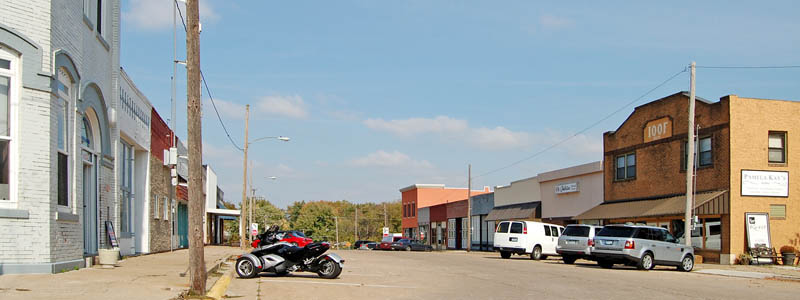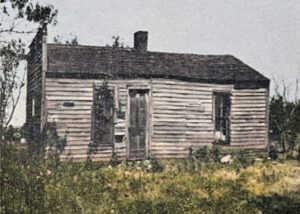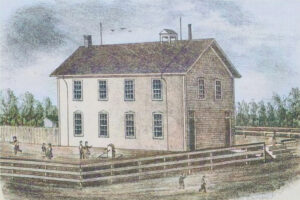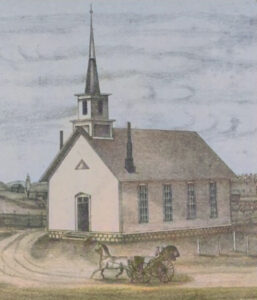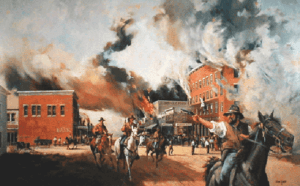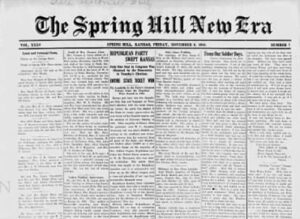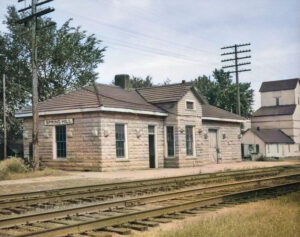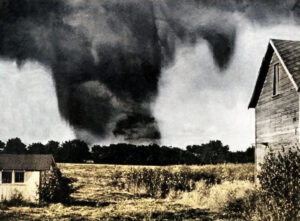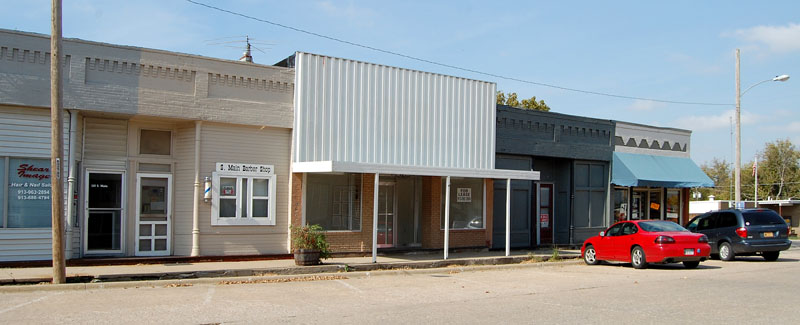Spring Hill, Kansas, is a city in Johnson and Miami Counties that is part of the Kansas City Metropolitan Area. As of the 2020 census, the population was 7,952, estimated to be 9,689 in 2023. The city has a total area of 9.46 square miles, of which 9.35 square miles is land and 0.11 square miles is water.
The first settler in the township was James B. Hovey, who arrived at the present location in March 1857. The surrounding country was gently undulating, the soil exceedingly fertile, and the vegetation luxurious. About two weeks afterward, William Mavity arrived. Afterward, S.B. Myrick and E.F. Davis took up the adjoining claims.
James B. Hovey and E.F. Davis became associated with holding the townsite. The town was surveyed on May 18, 1857, and was named after Spring Hill near Mobile, Alabama, a town Hovey considered one of the most beautiful he had ever seen.
“Being somewhat enthusiastic in my estimation of its future, it having all the advantages of timber and water, and on a line that must be traveled between Olathe and Paola, I concluded to myself, as there was no one else to conclude with, that this was a good place for a town.”
— James B. Hovey, 1857
Located just north of Miami County’s southern boundary, it is ten miles south of Olathe, the county seat.
The first farmer in the township was George Sprague, who settled in 1857 on land that adjoined the north half of the town on the east. He made the first improvements in the township, building the first good board fence, the first good barn, and the first good two-story dwelling.
Spring Hill’s post office opened on September 9, 1857, with James Hovey appointed the first postmaster. He also built the first building in town, the Spring Hill Hotel, on the square’s northeast corner. The two-story structure, also known as the “Old Traveler’s Rest,” was located on the highest elevation in town. The old stage line ran by Spring Hill Hotel.
A stage barn was erected 100 feet north of the hotel, where eight horses were kept and cared for. The drivers on the stage line changed horses here, and it was the duty of the stage barn owner to have these horses ready to hitch up as soon as the stage arrived. Stage barns were erected about every ten miles along the route, and just a few minutes were lost in changing horses. Four horses were driven at a time, and two changes of horses were made each day, with Pat Murphy in charge of the stable.
The first stage station was at Gum Springs, followed by Mahaffie Farmstead, northeast of Olathe; Squiresville, Spring Hill, Paola. Twin Springs, Moneka, north of Mound City; Fort Lincoln and Fort Scott. A telegraph line was established along the route.
In the fall of 1857, E.F. Davis sold his interest in the townsite to A.B. Simmons, William A. Jenkinson, J.P. Lockey, and James. Hovey sold some of his interest to H.E. Brown, James McKoin, and Edwin Walker. Many others, including D.F. Dayton, James Sweeting, W.G. Davidson, David Sprong, Hiram Mitchell, J.H. Jackson, Thomas Jenkinson, William Sowers, and W.R. Rutter, joined the settlement around that time.
On October 5, 1857, the first election for delegate to Congress, legislature member, justice of the peace, etc., occurred. At this first election, M.J. Parrott received a majority for the delegate to Congress, Edwin S. Nash for a member of the State Senate, and James B. Hovey and H.H. Wilcox were the first justices of the peace.
That year, Spring Hill was incorporated.
During the winters of 1857 and 1858, mail was carried on foot to Olathe and back once a week. There was no beaten road to guide the mail carriers as they trod through the snow.
In January 1858, a town company was formed with James B. Hovey as president and A.B. Simmons as secretary. That year, W.G. Davidson opened the first store, doing a very fair business with the stock he kept.
On March 22, 1858, an election was held for township officers when H.H. Wilcox and J.B. Hovey were elected justices; A.B. Squires and H.H. Wilcox, supervisors, and James B. Hovey, chairman of supervisors; William Mavity and Robert Victor, constables.
In the spring of 1858, A.D. Richardson, then a regular correspondent of the Boston Journal and since then attached to the New York Tribune, became very enthralled with eastern Kansas. On his way to Osawatomie, he stopped at Spring Hill and was highly pleased. Afterward, he bought an interest in the town and was admitted into the town company. Richardson evinced a lively interest in the town’s affairs and always used his influence for its welfare.
At about the same time, the Methodist Church was organized, and the first schoolhouse was built. Mrs. Duvall was the first teacher.
That year, Spring Hill’s mail route was changed and was distributed from Westport, Missouri, and J.H. Jackson of Spring Hill got the contract to carry it weekly.
The legislature of 1858-59 passed an act opening a state road from Leavenworth via Olathe, Spring Hill, Paola, and Mound City to Fort Scott.
In January 1859, Celia Ann Dayton, a doctor in Vermont, became the first woman doctor in Kansas by moving to Spring Hill. She arrived with her adopted son Hiram Eugene, who was also a doctor, and her husband Amos, who arrived a few months later.
In 1860, Mr. Prunty came from Parksville, Missouri, built a commodious store and dwelling, put in complete stock, and did very good business. The same year, A.B. Squires signed a contract to deliver the mail tri-weekly.
This was the year of great drought in Kansas. However, Spring Hill Township suffered little compared with other parts of the State. Though there was great scarcity and little of anything raised, the calls for aid from the township were very few and easily supplied.
The Presbyterian Church was organized in 1861 with four members, all women.
When the Civil War began in 1861, Spring Hill raised two companies for home protection, including a mounted company commanded by Captain James Duff and an infantry company commanded by Captain Hovey. One or the other of these companies was frequently requested to stand guard over some weak neighboring settlement threatened with fire and sword by some of the Missouri bushwhackers that infested the border that season. This kind of irregular service did not suit the men, as it was not either soldiering or farming, though it partook of the hardships of both. Frequently, area citizens slept with their guns in reach and perhaps with their clothes on, ready to start up with the first note of alarm.
During the same season, Captain Hill of Olathe began recruiting for active service in the field, and many men entered his company. With their regiment, Colonel R.B. Mitchell’s, they participated in the Battle of Wilson Creek, Missouri, under General National Lyon. In the meantime, Captain Duff, together with the men that remained, held himself ready for home service.
Hiram Dayton was killed in January 1862 during the Civil War after being discovered as a spy for the Union. That year, Celia divorced her husband, which was uncommon. Celia frequently aided black refugees and was reportedly part of the Underground Railroad. In the fall of 1862, Spring Hill avoided William Quantrill’s Raiders entering the town when a farmer talked to them on their way. He calmly convinced them there were soldiers in town when there were not. This deterred them from continuing.
That year, the mail was delivered daily on the regular Kansas City and Fort Scott mail route, which had been changed to come through Olathe.
In 1863, Quantrill’s Raiders marched on Spring Hill, looting businesses, stealing from local farmers, and killing at least one citizen.
In October 1864, the area had its last and biggest scare when General Sterling Price came through with a large army. In this critical situation, General Curtis issued an order putting the State under martial law and ordered every man to report for duty, with squads of patrol men bringing in delinquents.
A new, fine, large-frame schoolhouse was built in 1868 for about $4,000.
The Methodist Episcopal Organization erected a new church in 1868 for $2,700. By the early 1880s, the membership was 100.
The Presbyterian Church was built in 1869 for $2,700.
In 1869, the Missouri River, Fort Scott & Gulf Railroad reached the southern boundary of Johnson County. The town is situated on high land, and considerably cutting down through rock would be necessary if the road was built through or near the town. It would cost about $15,000. The people of Spring Hill were asked to contribute that sum to enable the company to build and establish a station in the town, but the citizens didn’t want to share the costs.
Instead, the road was built one-half mile east of the town, and their station was established at Ocheltree, two miles north. The town’s businesses quickly moved closer to the train depot and tracks.
The trains did not stop at Spring Hill for some time, and the people had to go to Ocheltree for their mail or travel on the train. This was very inconvenient, and an effort was made to induce the company to reconsider the matter of a station at Spring Hill. A.D. Richardson, who at the time owned 64 lots in the town, went to see Mr. Joy, with whom he was well acquainted and was successful. The people of Spring Hill and its vicinity soon contributed $1,500 toward putting in a side track.
The Spring Hill Enterprise was established on December 7, 1870, as a Republican journal by Buel & Sprague. Sprague bought out Buel’s interest on January 24, 1871, and soon associated with himself as Dr. Parker. Dr. Parker then bought out Sprague’s interest and conducted the paper as a Democratic journal for a time. In 1872, W. H. McGown became the owner, changed the name to Western Progress, and the politics to Republican.
The Methodist Protestant Church was organized in 1871.
That year, Miller, Gristy & Jenkinson built the Standard Mills for $25,000. The mill was three stories above the basement, had four runs of burhs, and could produce 80 barrels of flour in 24 hours. In addition to these mills, there were two small feed and grist mills, one driven by steam and the other by a windmill.
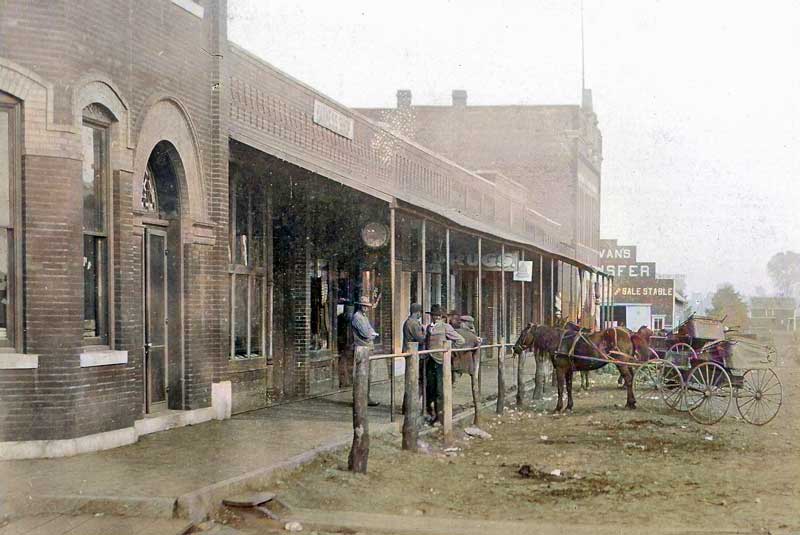
Sometime around the turn of the 20th Century in Spring Hill, Kansas. Touch of color by LOA.
In 1874, the country’s economic depression hit Spring Hill. That year, swarms of grasshoppers devoured plant life and then moved on to clothes, blankets, and shoes. Even leather harnesses, pitchfork handles, and fence posts were not immune to them. As a result, water sources were polluted, gardens and crops were devastated, and livestock suffered.
In 1878, the Methodist Protestant Church was built at about $1,200. A colored Baptist Church was also organized in Spring Hill.
By the early 1880s, Spring Hill had six general stores, a Grange store, dry goods, a grocery store, a furniture store, two hardware stores, three drug stores, two hotels, four blacksmiths, two agricultural implement dealers, two grain dealers, three mills, a newspaper, and about 700 inhabitants, including 215 children of school age.
June 1, 1882, Standard Mills became the property of H. L. McLachlin & Bros.
Johnson County’s oldest, continuous newspaper, the Spring Hill New Era, began operations in 1883. It was established in 1880 by J. W. Sowers. and later purchased by W. F. Wilkerson.
In 1898, Spring Hill began installing gas lights on Main Street. Daniel Bingham was responsible for lighting street lights with a 36-inch metal wand.
The Spring Hill Grange Fair began in 1904 as a stock and farm exhibit on the street. The following year, they leased two acres of ground adjoining the city on the south. After two successful fairs, the fair board leased 15 acres of ground for the third year, fenced it, erected a floral hall, put up stables and pens for stock, and made additions in years afterward.
By 1910, Spring Hill was the second largest town of Johnson County and was on the St. Louis and San Francisco Railroad. At that time, it had several general stores, a dry goods store, furniture, hardware, drug and implement houses, two hotels, agricultural implement dealers, a lumber yard, a money order post office, a telegraph, and express facilities. It was a shipping point for the rich farming community surrounding it. The population in 1910 was 700.
During these years, bandits and petty thieves came out of Kansas City and other parts of Missouri and found easy pickings in the small town of Spring Hill. Alarmed, Spring Hill residents formed the “Minute Men.” Two local banks supplied guns and ammunition to any able-bodied man… “able, under a stopwatch, to put on a shirt, trousers, shoes and a hat and get from their bedroom to the front porch in one minute flat.” “Some are required to go to the bandstand in the center of town, from which every roadway to the business center can be swept with rifle fire. Others are to go to the crossroads leading out of town and instructed not to let anyone pass.”
Electric lighting was installed in Spring Hill in 1911.
In 1915, Spring Hill was one of the best trading points on the Frisco railroad in eastern Kansas.

Downtown Spring Hill, Kansas early 1900s. Touch of color by LOA.
The Spring Hill Cooperative Association, managed by J. R. Lemen, owned the largest store in the city. Its building, measuring 80×100 feet, had an opera house on the second floor. It carried an excellent line of merchandise, had an excellent trade, and was one of the solid financial institutions of the town.
Hunger Nelson also carried a general stock of merchandise in the Odd Fellows building and was a progressive merchant, building up a permanent trade. E. Davis & Son had a model furniture store and undertaking parlors that competed with the larger towns in their line. Georg J Ellis carried a full line of hardware, and H.H. Neff and C. E. Baily were druggists.
Other well-conducted lines were a harness shop run by M.E. Black; a meat market by Ralph Hines; barber shops by E.A. Roofe and Jack Burns; R.E. Harbison’s tin shop; Allen’s jewelry store; Frank B. Jamison dealt in hay and feed and was an extensive buyer and shipper of stock; W.F. Hunter and A.H. Starbuck each ran blacksmith shops; and Mrs. M. E. Baily operated a millinery.
The Eagan restaurant and bakery were up-to-date shops; the Spring Hill elevator, managed by J.S. Null, did an extensive grain business, and the City Hotel, under the management of James Wykoff, provided great service to the traveling public. Four doctors and a dentist were present.
The Spring Hill Lumber Company, under the management of G.A. Simpson, carried a complete line of building materials. J.L. Todd ran the Spring Hill Creamery, W.W. Wickens managed the Telephone Company, and Clyde Elliot managed the municipal lighting plant.
On June 9, 1920, Alfred Gantert entered a local bank, asking for directions. The young man, dressed in greasy old clothes (under which he wore a brown suit, a silk shirt, British shoes, and a Stetson hat), locked bank employees in a vault. The alarm was sounded. With over $1,000 stuffed into his shirt, he took out across a wheat field, followed by a posse of “Minute Men.” Gantert was shot through the heart near a cedar tree in which he’d played as a child. His mother refused to claim the body, so Gantert was buried in the Paupers’ Field of the Spring Hill Cemetery.
“This minute man business may sound funny to high-salaried Hawkshaws and plain clothes men of the cities and may even make an ordinary cop smile. But it has produced some results…”
— Spring Hill New Era, 1920
The Spring Hill Rural High School District was established in the 1920s, and in 1926, A.H. Starbuck constructed the original city jail.
On May 20, 1957, around 7:00 p.m., an F5 tornado, known as the Ruskin Heights tornado, struck Spring Hill and surrounding towns. Neighbors tried to warn neighbors. Within minutes, much of Spring Hill was in splinters. Four members of the Isham Davis family were killed. A neighbor reported they were killed trying to leave their home and make it to their station wagon to escape the storm. The tornado destroyed their home, and their bodies were found nearby. Davis Street in Spring Hill is named after the family. The Elston Steel Factory, 21 homes, and 18 barns were destroyed. The cyclone then crossed into Missouri, striking Ruskin Heights and Hickman Mills. By nightfall, after 1 1/2 hours of destruction, 44 people were dead and over 200 injured.
In the 1960s, Spring Hill’s elementary and high schools merged due to a state law requiring public schooling for kindergarten through the 12th grade.
Spring Hill’s growth had nearly stopped by the 1980s until community leaders decided to focus on attracting industry. This strategy drew new residents, followed by increased retail and service businesses.
Today, many community events occur annually, including the King of the Hill Barbeque, the Spring Hill Fall Festival, and Hometown Holidays.
©Kathy Alexander/Legends of Kansas, February 2025.
Also See:
Sources:
Blackmar, Frank W.; Kansas: A Cyclopedia of State History, Vol I; Standard Publishing Company, Chicago, IL 1912.
Blair, Ed; History of Johnson County Kansas; Standard Publishing Company, Lawrence, Ks; 1915.
Cutler, William G; History of Kansas; A. T. Andreas, Chicago, IL, 1883.
Spring Hill Historic Brochure
Wikipedia

